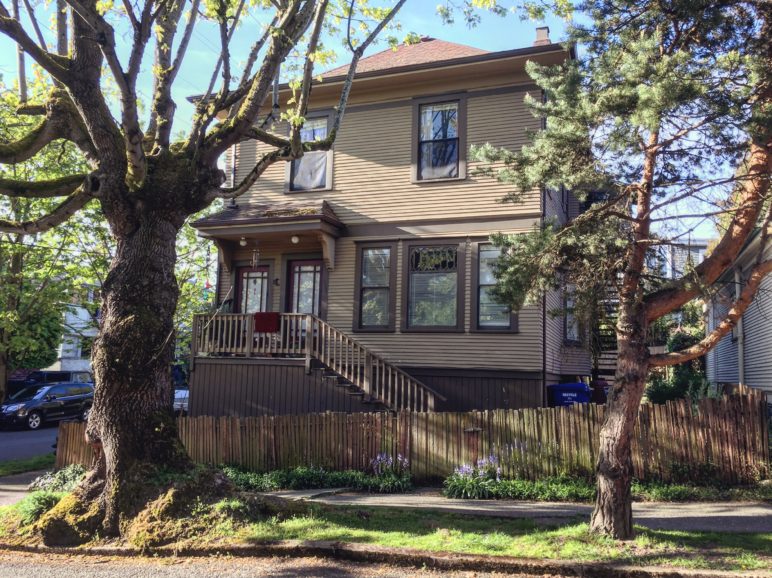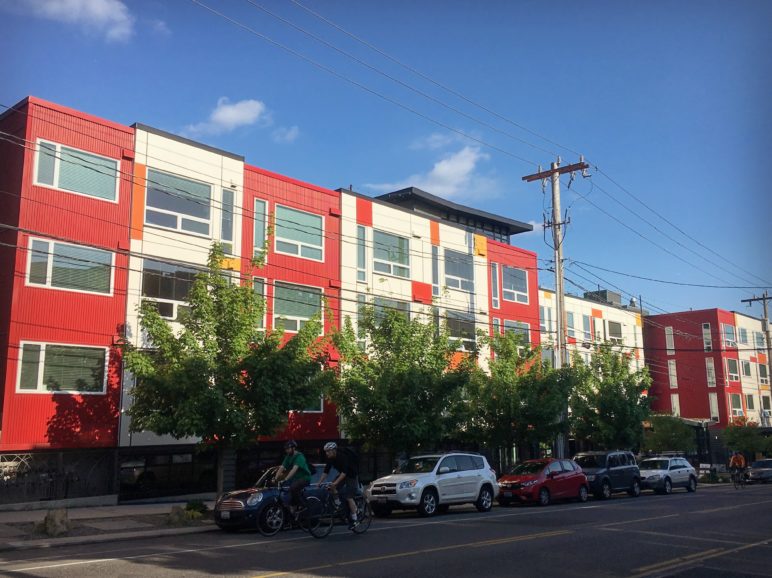The Sightline Housing and Urbanism team’s foremost theme of 2018 was Cascadia’s slow but sure progress toward re-legalizing modest multiple-dwelling homes on land previously locked away for suburban-style houses on big grassy lots. I add the “re” to “legalize” because historically in North American cities, duplexes, triplexes, courtyard homes, rowhouses and small apartments were sprinkled in with stand-alone houses.
Starting in the 1920s, cities began ratcheting down zoning restrictions on residences, and by the 1960s, most had banned anything but single-dwelling houses on vast swaths of their land—typically more than half of it. Re-opening these neighborhoods to more homes of all shapes and sizes is a critical part of the path to tackling our concurrent affordability and climate crises.
Let’s take a tour of Sightline’s 2018 articles that tell the latest stories.

How “lawn and driveway” zoning came to rule over cities
Here’s the play-by-play by guest author Mike Eliason on how Seattle slow walked into a housing shortage by putting more and more land off limits to multifamily homes. Likewise, check out how Portland’s 1924 and 1959 zoning ordinances, which banned apartments from much of the city, are still reflected in household incomes today, demonstrating how zoning puts up invisible walls of exclusion.
Status-quo zoning begets luxury housing
This Portland photo essay by Michael Andersen (who in May joined Sightline as a Senior Fellow) shows what happens today under status-quo single-family zoning: older, smaller houses get demolished and replaced with the biggest house that rules allow. And that’s the absolute worst outcome for affordability: a pricey McMansion for just one family with no increase in the stock of homes to help assuage the city’s housing shortage.
The gentlest density
The first step most cities take to expand housing options in areas reserved for single-family houses is legalizing mother-in-law apartments and backyard cottages, known as accessory dwelling units (ADUs). My colleague Margaret Morales penned a series explaining why ADUs are green (here, here and here), and affordable (here and here). Meanwhile, numerous Cascadian cities, large and small, moved to liberalize ADU rules—see our summary of 2018’s ADU wins for more details. In 2015, Seattle proposed a smart set of ADU updates that, frustratingly, remains mired in legal appeals filed by a wealthy neighborhood’s community council.

Rediscovering the missing middle
Cascadia’s big three—Portland, Seattle, and Vancouver, BC—are all pushing beyond ADUs to undo bans on “missing middle” housing types—that’s the buzzword for modest multifamily homes like triplexes, rowhouses, and small apartment buildings.
In 2015, Portland started developing a proposal to re-legalize missing middle homes in single-family zones. After three years of wrangling, the planning commission in September approved a plan that would allow triplexes and, potentially, fourplexes—though it’s not law of the land until the city council adopts it, likely in summer 2019. A key concept in Portland’s approach is to let buildings with more homes be bigger than buildings with fewer homes.
In June, Vancouver, BC, announced its “Making Room” strategy to open up single-family areas citywide to missing middle. Most of the plan will be hashed out over an 18-month process, but in September the city council re-legalized duplexes on 99 percent of the city’s low-density lots. Vancouver’s October election left Making Room on shakier ground, however.
For going on two years now, Seattle has been planning to convert 6 percent of its single-family land to small-scale multifamily, but anti-housing activists have stalled adoption through a legal appeal of the umbrella Mandatory Housing Affordability program. In any case, it’s only a baby step. Seattle has yet to act on its own 2015 recommendation to end single-family zoning citywide, but in December Seattle’s planning commission called for exactly that.
Meanwhile in November, Olympia, Washington, showed up Cascadia’s big three by legalizing more types of modest multifamily dwellings citywide. And though it’s well outside Cascadia, how could we not tout Minneapolis, which in December approved a plan to permit triplexes throughout the half of the city currently restricted by zoning laws to one house per lot (the plan also eliminates parking mandates and allows bigger buildings near transit).

High costs make housing expensive (but don’t blame the developers)
In 2018 we also advanced our work connecting homebuilding costs and affordability. By mid-year, apartment rents in Seattle and Portland had plateaued, illustrating how adding new homes can turn around rising rents, and how officials can maximize these affordability gains by minimizing regulatory costs.
Drilling deeper, we teased apart the costs that go into building and operating typical new apartments in Portland and Seattle. The results bust the myth that “greedy developers” are to blame for high rents: the developer’s take typically accounts for around 10 percent of the tenant’s rent check. Overall, the studies show that market rents simply reflect the high cost of developing and running apartment buildings—and though we do have ways to reduce those costs, none of them are easy.
Our focus groups confirmed that average people are skeptical that reducing regulatory costs helps affordability, and gravitate instead toward more housing options and opportunity. Relatedly, a remarkable UCLA study revealed that much myth-busting work remains, finding that the strongest catalyst of opposition to homebuilding projects—much stronger even than concerns over parking, traffic, or neighborhood character—is the premise that developers will make “a large profit.”

More 2018 notables
Cities can build up—a lot!—and still keep lots of trees around: Seattle’s latest study of tree canopy cover showed no measurable loss of trees in the areas that absorbed almost all of the city’s 76,000 new residents and 65,000 new jobs from 2007 to 2015. Portland has also been maintaining the tree count while growing rapidly in its multifamily and commercial areas.
Portland schools the nation on smart parking reform: In November, the city agreed to repurpose 1,000 curbside parking spaces for dedicated bus lanes, a protected bike lane network, and better crosswalks. These steps followed its August adoption of new parking policies to adjust meter prices up or down based on the number of people using them and to invest half of meter revenues in any new parking districts to support alternatives to driving there.
Guest author Erica C. Barnett served up a grab bag of innovations: how industrial land could accommodate housing; the potential for modular construction to reduce the cost of homebuilding; and using surplus publicly-owned land for affordable housing development.
Is state-level action the next big thing?
In early 2018, California legislators proposed an ill-fated bill that would have required cities to allow more housing near transit, sparking a national debate over the need for state-level action to overcome local resistance to loosening zoning restrictions. Sightline expects this approach to gain momentum, and in November published a survey of past state- and province-led efforts in Cascadia.
We are also tracking several state bills legislators are cooking up for Cascadia. Potentially on the table in 2019 in Washington: density minimums for zoning adjacent to transit, prohibition of regulatory barriers to ADUs, new funding for affordable housing through bonding against sales tax and a real estate excise tax, streamlining environmental review, and condominium warranty reform. In the works for Oregon: legalization of fourplexes, more homes, densely assembled, near transit, tenant protections, and repeal of the state ban on rent control. Portland’s planned Southwest Corridor light rail extension exemplifies the need for state mandates to liberalize zoning near transit.
You can find all of Sightline’s housing and urbanism articles here.
Catch you next year!


Comments are closed.